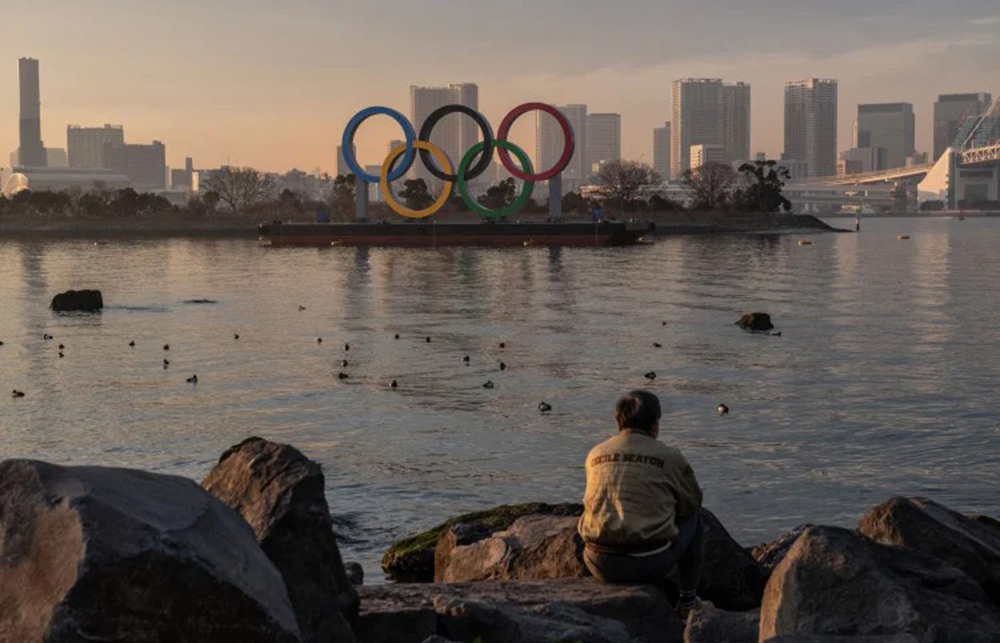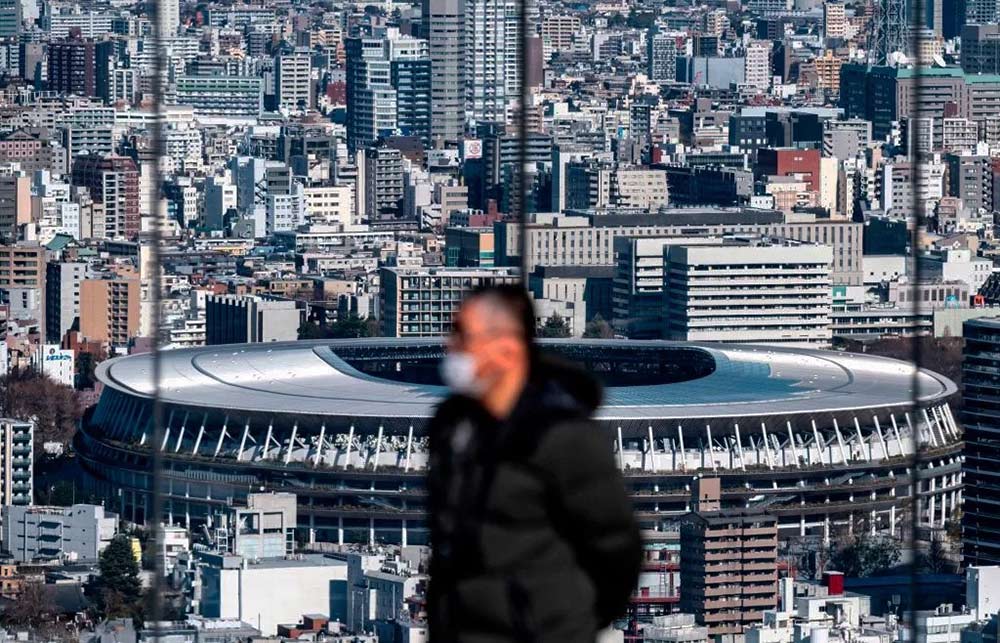受新冠疫情影響,東京被迫推遲了原定于去年舉辦的2020年夏季奧運會和殘奧會,并下定決心在2021年7月23日至8月8日期間舉辦。
在今年1月舉辦的世界經濟論壇上,日本首相菅義偉對代表團表示,推遲舉辦的夏季奧運會將是“人類戰勝病毒的證明。”
但目前看來,勝利仍然遙遙無期。

日本于2月17日啟動新冠疫苗接種工作,政府為作為首批接種對象的一線醫護人員分配了40,000劑輝瑞疫苗。但美聯社引用專家的話稱,在7月奧運會開幕之前,日本不可能靠疫苗實現群體免疫。
與此同時,全球多個人口大國仍然無法控制每日新增病例,而且疫苗至少還要再等一年才能夠在全球大范圍施打。時至今日,日本仍有多個縣為了應對突如其來的新一輪疫情高潮,宣布進入了緊急狀態。
2月2日,菅義偉將緊急狀態延長至3月7日,因為雖然病例有所減少,但醫院依舊疲于應付。
由于新冠病毒仍然無法得到控制,日本國民已經對奧運會失去了興趣。
據日本共同社的一項調查顯示,80%的受訪者希望取消2020年奧運會(現在要稱為2021年奧運會)或者再次改期舉行。
但菅義偉和東京奧組委的前主席森喜朗(他曾經稱女性說話太多,并因為這番性別歧視言論在2月下臺)卻執意要繼續舉辦奧運會。
在日本執政黨自民黨于2月召開的會議上,森喜朗對議員們表示:“無論新冠疫情形勢如何,我們都將舉辦奧運會。”他指出,政府應該討論如何舉辦奧運會,而不是是否舉辦奧運會。
森喜朗的態度與國際奧委會主席托馬斯?巴赫在1月召開的新聞發布會上所表達的立場如出一轍。他對記者稱:“我們不會再糾結于是否舉辦奧運會,我們要解決的是如何舉辦奧運會。”
那么,2021年奧運會到底將如何舉辦?是否需要隔離?
2月3日,東京奧委會向參加奧運會的運動聯合會官員發布了一份“手冊”,回答了關于如何舉辦奧運會的部分問題。手冊中說明了奧運會期間將會執行的防疫限制措施。

根據規定,奧運會的官方人員需要在前往東京的前兩周,開始監測個人健康狀況,報備抵達日本前14天的行程。在日本期間,不能離開住所,除非需要前往奧運比賽場館處理相關事務。除此之外,官方人員還必須與其他人保持至少一米距離,與運動員保持至少兩米距離。
代表團成員在登機飛往日本之前,還需要出具新冠檢測陰性證明,而且在抵達日本后需再次接受檢測。然后他們將被送往居住地點,不需要接受隔離。運動員也需要遵守專門的“疫情應對措施手冊”。
運動員會受到哪些影響?
2020年12月,國際奧委會確認,運動員不得在首個比賽日之前提前超過五天抵達奧運村,并且,必須在最后一次比賽之后的兩天內離開奧運村。
正常情況下,運動員在奧運會期間可以全程居住在奧運村,直到結束最后一場比賽和閉幕式。一般來說,主辦國會歡迎運動員提前入駐:2016年里約熱內盧奧運會期間,有部分運動員在奧運會開幕前兩周就已經抵達奧運村。
運動員通常會提前抵達奧運會主辦國,在比賽之前適應新的環境。而這屆特殊的奧運會,運動員如果提前超過五天前往日本,也不能提前進入奧運村。
與奧運官方人員一樣,運動員也需要在抵達奧運村前兩周開始監測健康狀況。
但根據2020年東京奧運會的運動員版疫情應對措施手冊,參加夏季奧運會的運動員在抵達后不需要隔離,也不需要提前接種疫苗。運動員必須提供飛往日本之前72小時內的新冠檢測陰性報告。

運動員入境日本之后的疫情應對措施與奧運官員基本相同。這些措施包括前14天遵守提前準備的日程安排,記錄所有密切接觸者,不能離開場地,并且除了比賽或訓練以外,必須佩戴口罩。不建議有擁抱、擊掌、握手等身體接觸。
比賽是否會有現場觀眾?
考慮到2021年東京奧運會可能會演變成一場大規模病毒傳播事件的風險,國際奧委會尚未決定今年奧運會是否歡迎國外觀眾。
森喜朗之前曾向記者表示,最晚將在3月之前就這個問題做出決定。如今時間已經到了2月底,森喜朗直到辭職也未就這一問題給出明確答復。但據2月中旬的調查顯示,49%的日本公司希望東京奧運會限制現場觀眾人數,43%的公司要求沒有觀眾。
以往的夏季奧運會熱鬧非凡,拒絕外國觀眾將使比賽現場變得死氣沉沉,但這并不是第一次在空無一人的體育場內舉辦的體育活動。
2020年,有多項體育聯賽都嘗試了虛擬觀眾、在座位上擺放紙板人,并通過揚聲器在空蕩蕩的體育場內播放預先錄制的歡呼聲等措施。
除了比賽氛圍受影響之外,拒絕現場觀眾也將讓東京損失慘重。據東京奧組委的運營預算顯示,預計東京奧運會的門票收入為8億美元,即便其中大部分收入來自國內銷售。
在680萬張門票中,去年國內觀眾購買了約75%。但在奧運會延期后,組委會被迫向觀眾退款。
如果奧運會沒有外國觀眾,還會讓東京對奧運會帶動旅游消費的期待落空。盡管外交關系協會的報告稱,旅游業從來都不是主辦城市的主要收入來源。
無論是本地觀眾還是海外觀眾,或許最令人沮喪的是,比賽現場可能不允許唱歌或呼喊口號。因為手冊中提倡用鼓掌來替代這些。
本屆奧運會需要多少成本?
2020年東京奧運會已經是史上最昂貴的夏季奧運會,總預算高達154億美元,超過了2012年的倫敦奧運會。倫敦奧運會的成本為149.6億美元。
東京奧運會也可能是史上超支最嚴重的夏季奧運會。畢竟東京市政府在2013年角逐奧運主辦權時,預測的成本只有73億美元。
雖然東京努力減少不必要的開支,例如歡迎宴會、奧運景觀和工作人員人數等,但成本依舊在不斷增加。
2020年10月,東京奧組委稱,通過減少不必要的開支節省了約2.8億美元,但必要的疫情應對措施卻額外增加了9.2億美元支出。
超支的成本大部分將由日本政府和東京市政府承擔。國際奧委會在2020年東京奧運會籌辦程序開始時撥款8億美元,除此之外不會提供額外資金。
不過國際奧委會在去年12月宣布,將免除奧運贊助商7.6%的特許權使用費,因為東京希望與更多贊助商簽約,用于支付奧運會延期的成本。
品牌商是否依舊會贊助奧運會?
據東京奧組委的最新預算顯示,“本地贊助”,即本地公司投放的廣告,將產生33億美元收入,是東京市最大的收入來源。這比之前任何一屆奧運會的贊助收入增加了一倍以上。
但路透社報道稱,多家奧運贊助商需要進一步評估現場氣氛之后,再發布奧運廣告片。
由于日本抵制奧運會的民意洶涌,因此贊助奧運會對品牌商失去了吸引力,而且觀眾減少,禁止歡呼吶喊,可能導致現場的氣氛難以起到贊助商想要的那種效果。
至于廣告商如何為今年沉悶的奧運會設計廣告片,奧運圣火傳遞活動將是第一次試驗。
這場儀式性的超級馬拉松定于3月25日開始,為期四個月,奧運火炬將穿越日本27個縣,會有10,000名火炬手參與。
去年,森喜朗曾呼吁觀看圣火傳遞的觀眾要“克制”,但東京奧委會在2020年3月24日宣布該活動取消,當時距離原定的圣火傳遞開始日期只有兩天。
這一決定意味著時任首相安倍晉三最終向現實低頭,并推遲舉辦奧運會。
今年的圣火傳遞活動同樣受到密切關注。2月中旬,島根縣知事丸山達也威脅要取消在該縣境內的奧運圣火傳遞,他認為這場萬人活動對創造“我們可以安全觀看奧運比賽的環境”沒有幫助。
丸山達還表示,“如果當前的情況持續下去”,應該取消奧運會。
奧運會的轉播和媒體報道是否會有變化?
作為一家非營利組織,國際奧委會超過90%的收入來自奧運會轉播權銷售,并且通常會一次性出售數年的轉播權,同時涵蓋了冬季和夏季奧運會。
國際奧委會出售2017年至2020年四年的轉播權,共獲得超過40億美元。
但2020年東京奧運會推遲舉行,影響了國際奧委會的現金流,并且部分轉播商可能會重新談判當前的合同。
更糟糕的是,如果奧運會最終取消,轉播商將要求奧委會退款。
所以今年奧運會的轉播會如期進行,媒體也將參與報道,只是數量會有所減少。根據媒體疫情應對措施手冊的規定,社交距離要求讓奧運場館媒體區域的容量減少了50%。
賽后采訪的形式也可能與以往不同,運動員和采訪記者必須保持兩米間隔,這將會給觀眾帶來一種與以往截然不同的感受。
東京奧運會觀眾數量的減少、停滯不前的旅游業、有限的媒體報道、運動員之間需要保持的距離……種種表現皆說明這屆奧運會并不是一場供人類慶祝劫后余生的盛會,反而是在提醒我們:疫情依舊不容樂觀。(財富中文網)
翻譯:劉進龍
審校:汪皓
受新冠疫情影響,東京被迫推遲了原定于去年舉辦的2020年夏季奧運會和殘奧會,并下定決心在2021年7月23日至8月8日期間舉辦。
在今年1月舉辦的世界經濟論壇上,日本首相菅義偉對代表團表示,推遲舉辦的夏季奧運會將是“人類戰勝病毒的證明。”
但目前看來,勝利仍然遙遙無期。
日本于2月17日啟動新冠疫苗接種工作,政府為作為首批接種對象的一線醫護人員分配了40,000劑輝瑞疫苗。但美聯社引用專家的話稱,在7月奧運會開幕之前,日本不可能靠疫苗實現群體免疫。
與此同時,全球多個人口大國仍然無法控制每日新增病例,而且疫苗至少還要再等一年才能夠在全球大范圍施打。時至今日,日本仍有多個縣為了應對突如其來的新一輪疫情高潮,宣布進入了緊急狀態。
2月2日,菅義偉將緊急狀態延長至3月7日,因為雖然病例有所減少,但醫院依舊疲于應付。
由于新冠病毒仍然無法得到控制,日本國民已經對奧運會失去了興趣。
據日本共同社的一項調查顯示,80%的受訪者希望取消2020年奧運會(現在要稱為2021年奧運會)或者再次改期舉行。
但菅義偉和東京奧組委的前主席森喜朗(他曾經稱女性說話太多,并因為這番性別歧視言論在2月下臺)卻執意要繼續舉辦奧運會。
在日本執政黨自民黨于2月召開的會議上,森喜朗對議員們表示:“無論新冠疫情形勢如何,我們都將舉辦奧運會。”他指出,政府應該討論如何舉辦奧運會,而不是是否舉辦奧運會。
森喜朗的態度與國際奧委會主席托馬斯?巴赫在1月召開的新聞發布會上所表達的立場如出一轍。他對記者稱:“我們不會再糾結于是否舉辦奧運會,我們要解決的是如何舉辦奧運會。”
那么,2021年奧運會到底將如何舉辦?是否需要隔離?
2月3日,東京奧委會向參加奧運會的運動聯合會官員發布了一份“手冊”,回答了關于如何舉辦奧運會的部分問題。手冊中說明了奧運會期間將會執行的防疫限制措施。
根據規定,奧運會的官方人員需要在前往東京的前兩周,開始監測個人健康狀況,報備抵達日本前14天的行程。在日本期間,不能離開住所,除非需要前往奧運比賽場館處理相關事務。除此之外,官方人員還必須與其他人保持至少一米距離,與運動員保持至少兩米距離。
代表團成員在登機飛往日本之前,還需要出具新冠檢測陰性證明,而且在抵達日本后需再次接受檢測。然后他們將被送往居住地點,不需要接受隔離。運動員也需要遵守專門的“疫情應對措施手冊”。
運動員會受到哪些影響?
2020年12月,國際奧委會確認,運動員不得在首個比賽日之前提前超過五天抵達奧運村,并且,必須在最后一次比賽之后的兩天內離開奧運村。
正常情況下,運動員在奧運會期間可以全程居住在奧運村,直到結束最后一場比賽和閉幕式。一般來說,主辦國會歡迎運動員提前入駐:2016年里約熱內盧奧運會期間,有部分運動員在奧運會開幕前兩周就已經抵達奧運村。
運動員通常會提前抵達奧運會主辦國,在比賽之前適應新的環境。而這屆特殊的奧運會,運動員如果提前超過五天前往日本,也不能提前進入奧運村。
與奧運官方人員一樣,運動員也需要在抵達奧運村前兩周開始監測健康狀況。
但根據2020年東京奧運會的運動員版疫情應對措施手冊,參加夏季奧運會的運動員在抵達后不需要隔離,也不需要提前接種疫苗。運動員必須提供飛往日本之前72小時內的新冠檢測陰性報告。
運動員入境日本之后的疫情應對措施與奧運官員基本相同。這些措施包括前14天遵守提前準備的日程安排,記錄所有密切接觸者,不能離開場地,并且除了比賽或訓練以外,必須佩戴口罩。不建議有擁抱、擊掌、握手等身體接觸。
比賽是否會有現場觀眾?
考慮到2021年東京奧運會可能會演變成一場大規模病毒傳播事件的風險,國際奧委會尚未決定今年奧運會是否歡迎國外觀眾。
森喜朗之前曾向記者表示,最晚將在3月之前就這個問題做出決定。如今時間已經到了2月底,森喜朗直到辭職也未就這一問題給出明確答復。但據2月中旬的調查顯示,49%的日本公司希望東京奧運會限制現場觀眾人數,43%的公司要求沒有觀眾。
以往的夏季奧運會熱鬧非凡,拒絕外國觀眾將使比賽現場變得死氣沉沉,但這并不是第一次在空無一人的體育場內舉辦的體育活動。
2020年,有多項體育聯賽都嘗試了虛擬觀眾、在座位上擺放紙板人,并通過揚聲器在空蕩蕩的體育場內播放預先錄制的歡呼聲等措施。
除了比賽氛圍受影響之外,拒絕現場觀眾也將讓東京損失慘重。據東京奧組委的運營預算顯示,預計東京奧運會的門票收入為8億美元,即便其中大部分收入來自國內銷售。
在680萬張門票中,去年國內觀眾購買了約75%。但在奧運會延期后,組委會被迫向觀眾退款。
如果奧運會沒有外國觀眾,還會讓東京對奧運會帶動旅游消費的期待落空。盡管外交關系協會的報告稱,旅游業從來都不是主辦城市的主要收入來源。
無論是本地觀眾還是海外觀眾,或許最令人沮喪的是,比賽現場可能不允許唱歌或呼喊口號。因為手冊中提倡用鼓掌來替代這些。
本屆奧運會需要多少成本?
2020年東京奧運會已經是史上最昂貴的夏季奧運會,總預算高達154億美元,超過了2012年的倫敦奧運會。倫敦奧運會的成本為149.6億美元。
東京奧運會也可能是史上超支最嚴重的夏季奧運會。畢竟東京市政府在2013年角逐奧運主辦權時,預測的成本只有73億美元。
雖然東京努力減少不必要的開支,例如歡迎宴會、奧運景觀和工作人員人數等,但成本依舊在不斷增加。
2020年10月,東京奧組委稱,通過減少不必要的開支節省了約2.8億美元,但必要的疫情應對措施卻額外增加了9.2億美元支出。
超支的成本大部分將由日本政府和東京市政府承擔。國際奧委會在2020年東京奧運會籌辦程序開始時撥款8億美元,除此之外不會提供額外資金。
不過國際奧委會在去年12月宣布,將免除奧運贊助商7.6%的特許權使用費,因為東京希望與更多贊助商簽約,用于支付奧運會延期的成本。
品牌商是否依舊會贊助奧運會?
據東京奧組委的最新預算顯示,“本地贊助”,即本地公司投放的廣告,將產生33億美元收入,是東京市最大的收入來源。這比之前任何一屆奧運會的贊助收入增加了一倍以上。
但路透社報道稱,多家奧運贊助商需要進一步評估現場氣氛之后,再發布奧運廣告片。
由于日本抵制奧運會的民意洶涌,因此贊助奧運會對品牌商失去了吸引力,而且觀眾減少,禁止歡呼吶喊,可能導致現場的氣氛難以起到贊助商想要的那種效果。
至于廣告商如何為今年沉悶的奧運會設計廣告片,奧運圣火傳遞活動將是第一次試驗。
這場儀式性的超級馬拉松定于3月25日開始,為期四個月,奧運火炬將穿越日本27個縣,會有10,000名火炬手參與。
去年,森喜朗曾呼吁觀看圣火傳遞的觀眾要“克制”,但東京奧委會在2020年3月24日宣布該活動取消,當時距離原定的圣火傳遞開始日期只有兩天。
這一決定意味著時任首相安倍晉三最終向現實低頭,并推遲舉辦奧運會。
今年的圣火傳遞活動同樣受到密切關注。2月中旬,島根縣知事丸山達也威脅要取消在該縣境內的奧運圣火傳遞,他認為這場萬人活動對創造“我們可以安全觀看奧運比賽的環境”沒有幫助。
丸山達還表示,“如果當前的情況持續下去”,應該取消奧運會。
奧運會的轉播和媒體報道是否會有變化?
作為一家非營利組織,國際奧委會超過90%的收入來自奧運會轉播權銷售,并且通常會一次性出售數年的轉播權,同時涵蓋了冬季和夏季奧運會。
國際奧委會出售2017年至2020年四年的轉播權,共獲得超過40億美元。
但2020年東京奧運會推遲舉行,影響了國際奧委會的現金流,并且部分轉播商可能會重新談判當前的合同。
更糟糕的是,如果奧運會最終取消,轉播商將要求奧委會退款。
所以今年奧運會的轉播會如期進行,媒體也將參與報道,只是數量會有所減少。根據媒體疫情應對措施手冊的規定,社交距離要求讓奧運場館媒體區域的容量減少了50%。
賽后采訪的形式也可能與以往不同,運動員和采訪記者必須保持兩米間隔,這將會給觀眾帶來一種與以往截然不同的感受。
東京奧運會觀眾數量的減少、停滯不前的旅游業、有限的媒體報道、運動員之間需要保持的距離……種種表現皆說明這屆奧運會并不是一場供人類慶祝劫后余生的盛會,反而是在提醒我們:疫情依舊不容樂觀。(財富中文網)
翻譯:劉進龍
審校:汪皓
Tokyo is determined to hold the 2020 Olympics and Paralympics this year, after the pandemic forced the city to postpone the Games last year, rescheduling them for July 23 through Aug. 8, 2021.
At the World Economic Forum in January, Japan Prime Minister Suga Yoshihide told delegates that the postponed Summer Games will serve as “proof of mankind’s victory over the virus.” Thing is, that triumph hasn’t happened yet.
Vaccine rollouts began in Japan on Feb. 17, with the government dispensing 40,000 Pfizer vaccines to frontline health workers. But experts cited by the Associated Press say Japan won't reach herd immunity from vaccines before the Olympics start in July.
Meanwhile, many of the world’s most populous countries are still struggling to get daily case numbers under control, and vaccines aren't expected to be widespread globally for at least another year. Even in Japan, several prefectures are under a state of emergency to combat a sudden wave of COVID-19.
On Feb. 2, Yoshihide extended the state of emergency to March 7, as hospitals struggled to cope even as cases declined. With the virus still far from contained, Japan’s citizens have lost their Olympic spirit.
According to a poll by Kyodo News, 80% of respondents want to see the 2020—now 2021—Olympics cancelled or rescheduled again. But Suga and the former head of Tokyo’s Olympic Committee, Yoshiro Mori (who stepped down in February following the outcry over his sexist comments about women talking too much) vowed to press on.
“No matter what the situation will be with the coronavirus, we will hold the Games,” Mori told lawmakers at a Feb. 2 meeting of Japan’s ruling Liberal Democratic Party. Mori said the government should move on from discussing whether to hold the Games and instead discuss how to hold the Games.
Mori’s message echoed the sentiment expressed by International Olympic Committee President Thomas Bach during a news conference in January. He told reporters, “We are not speculating whether the Games will take place. We are working on how the Games will take place.”
So what will the 2021 Olympics look like? Will there be quarantines?
On Feb. 3, the Tokyo Olympic Committee answered at least part of the “how” question when it issued a “playbook” to participating sports federation officials, outlining the pandemic restrictions that will be in place during the Games.
According to the rules, officials will be required to start monitoring their health and temperature two weeks before flying to Tokyo. The delegates will also need to show a negative COVID-19 test before boarding flights to Japan and, once they arrive, officials will be tested again and then shuttled to their accommodation but won't have to quarantine.
The officials have to map out an itinerary for the first 14 days of their visit, when they will not be allowed to exit their accommodation unless visiting the Olympic Games venues on related business.
While in Tokyo, officials must keep at least one meter apart from other people but are required to stay at least two meters away from athletes, who have their own “playbook” of rules to follow.
How will athletes be affected?
In December, the International Olympic Committee confirmed that athletes won't be allowed to enter the Olympic Village more than five days prior to their first event and have to leave again within two days of their final competition.
Ordinarily, athletes can spend the entire duration of the Games at the Village—beyond their final event and up to the closing ceremony. Athletes are usually welcome to arrive early too: At the 2016 Olympics in Rio de Janeiro, some competitors arrived two weeks before the Games started.
Athletes usually arrive in a host country well ahead of time so that they can acclimatize before competing. For the Tokyo Olympics, it's possible athletes will be able to travel to Japan more than five days before their meets; they just won't be able to access the Olympic Village far in advance.
Much like Olympic officials, athletes will have to begin monitoring their health two weeks prior to arriving at the Olympic Village. But according to the Tokyo 2020 playbook for athletes, competitors at the Summer Games won't be required to quarantine on arrival nor do they need to have been vaccinated in order to attend. Athletes have to present a negative COVID-19 test, taken up to 72 hours prior to their flight to Japan.
Once in Japan, athletes are under broadly the same restrictions as Olympic officials. That includes sticking to a prepared schedule for the first 14 days, recording all close contact with others, remaining on-site, and wearing masks except when competing or training. Physical contact, like hugging, high fives, and handshakes, is discouraged.
Will there be spectators?
With the risks of Tokyo 2021 turning into a major superspreader event, the IOC has yet to determine whether international fans will be welcome at this year’s Olympics. Mori previously told reporters that a decision on the issue would be made by March at the latest.
Denying international fans would dampen the usually jubilant atmosphere of the Summer Games, but it wouldn’t be the first sports event to be held in front of an empty stadium. During 2020, various sports leagues experimented with virtual audiences, cardboard-cutout seat fillers, and canned cheers piped into empty stadiums through loudspeakers.
Banning fans would come at a financial cost to Tokyo. Tokyo expected to raise $800 million in ticket sales for the Olympics, according to the committee’s operating budget, although most of that revenue would come from domestic sales. Roughly 75% of the 6.8 million available tickets were bought by domestic fans last year, although the organizers were forced to issue refunds after the Games were delayed.
Having no international fans at the Games would also eliminate the bump in tourism spending Tokyo expected the Olympics to bring, although the Council on Foreign Relations reports that tourism isn’t always a significant revenue stream for host cities.
Perhaps most depressingly, whether spectators are local or from overseas, there will be no singing or chanting allowed when the Games commence. The playbook for officials advocates clapping instead.
How much will the Games cost?
The Tokyo 2020 Olympics is already the most expensive Summer Games on record, with a total budget of $15.4 billion—stealing the title from London's 2012 Olympics, which cost $14.96 billion. Tokyo is also perhaps the most over-budget Summer Games, with the government originally predicting a cost of $7.3 billion when Tokyo made its host bid in 2013.
The costs have mounted despite Tokyo's attempts to cut back on frills, such as welcome parties, the "look" of the Games, and the number of support staff attending. In October, the organizing committees said they had saved $280 million through such cuts, but necessary coronavirus countermeasures have added an extra $920 million to the expense sheet.
Most of the additional costs will be covered by the national and Tokyo-level governments. The IOC isn't providing any additional funds beyond the $800 million it contributed to the Tokyo 2020 costs at the outset of the Olympic process.
However, in December the IOC said it will waive a 7.6% royalty fee it usually collects on Olympic sponsorship deals, as Tokyo seeks more sponsors to cover the costs of the delayed Olympics.
Are brands still sponsoring the Games?
According to the Tokyo committee’s latest budget, “local sponsorship,” meaning advertising, will be the city’s biggest earner, generating $3.3 billion in revenue. That's more than twice the sponsorship earned by any previous Games.
But Reuters reports a number of Olympic sponsors are holding off on launching their Olympic advertising campaigns until they can better gauge the mood of the occasion.
With public opinion in Japan heavily against the Games, supporting the event doesn’t carry the same appeal for brands and, with fewer fans and no cheering allowed, the atmosphere will likely be less inspirational.
The Olympic Torch relay will be the first test of how advertisers try to frame this year’s subdued Olympics. The ritualistic ultramarathon that will see the Olympic flame pass between 10,000 torch bearers across Japan's 27 prefectures over the course of four months is due to start on March 25.
Last year, Mori had called for crowds watching the relay to be "restrained," but then the Tokyo Olympic Committee cancelled the run on March 24, 2020, two days before it was due to start, signaling that then Prime Minister Abe Shinzo finally had succumbed to reality and postponed the Games.
This year's torch relay is also under scrutiny. In mid-February, Maruyama Tatsuya, the minister of Shimane prefecture, threatened to cancel the region's participation in the relay and suggested the 10,000-person event wouldn't contribute to an "environment where we can safely enjoy the Olympics." Maruyama also said the Olympics should be cancelled "if the present conditions continue."
Are there any changes to the Olympics’ broadcast and press coverage?
The nonprofit International Olympic Committee makes over 90% of its revenue from selling broadcast rights to the Olympic Games, which it tends to sell in multiyear chunks that cover both Winter and Summer Games. The IOC made over $4 billion from the sale of broadcast rights for the four-year period from 2017 through 2020.
But the delayed start of Tokyo 2020 has hindered the IOC's cash flow and introduced the risk that some broadcasters might renegotiate their current contracts. Worse, a cancellation of the Games could result in broadcasters demanding refunds.
So broadcasts of this year's Olympics will go ahead, and the press will be in attendance too, albeit in smaller numbers. According to the playbook for the press, social distancing requirements have reduced the capacity of Olympic venue press rooms by 50%.
Postgame interviews will likely look and feel different, too, with athletes and interviewers maintaining a mandatory two-meter distance.
With fewer fans, little—if any—tourism, less media, and socially distanced athletes, the Tokyo Olympics risks becoming a pertinent reminder of how very prevalent the pandemic still is, rather than a post-pandemic celebration of triumph over adversity.






